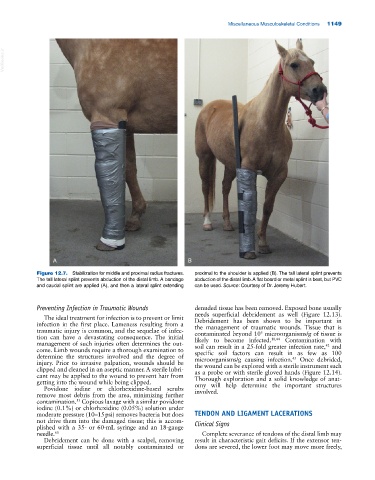Page 1183 - Adams and Stashak's Lameness in Horses, 7th Edition
P. 1183
Miscellaneous Musculoskeletal Conditions 1149
VetBooks.ir
A B
Figure 12.7. Stabilization for middle and proximal radius fractures. proximal to the shoulder is applied (B). The tall lateral splint prevents
The tall lateral splint prevents abduction of the distal limb. A bandage abduction of the distal limb. A flat board or metal splint is best, but PVC
and caudal splint are applied (A), and then a lateral splint extending can be used. Source: Courtesy of Dr. Jeremy Hubert.
Preventing Infection in Traumatic Wounds denuded tissue has been removed. Exposed bone usually
needs superficial debridement as well (Figure 12.13).
The ideal treatment for infection is to prevent or limit Debridement has been shown to be important in
infection in the first place. Lameness resulting from a the management of traumatic wounds. Tissue that is
traumatic injury is common, and the sequelae of infec contaminated beyond 10 microorganisms/g of tissue is
5
tion can have a devastating consequence. The initial likely to become infected. 18,44 Contamination with
management of such injuries often determines the out soil can result in a 25‐fold greater infection rate, and
42
come. Limb wounds require a thorough examination to specific soil factors can result in as few as 100
determine the structures involved and the degree of microorganisms/g causing infection. Once debrided,
43
injury. Prior to invasive palpation, wounds should be the wound can be explored with a sterile instrument such
clipped and cleaned in an aseptic manner. A sterile lubri as a probe or with sterile gloved hands (Figure 12.14).
cant may be applied to the wound to prevent hair from Thorough exploration and a solid knowledge of anat
getting into the wound while being clipped. omy will help determine the important structures
Povidone iodine or chlorhexidine‐based scrubs
remove most debris from the area, minimizing further involved.
contamination. Copious lavage with a similar povidone
53
iodine (0.1%) or chlorhexidine (0.05%) solution under
moderate pressure (10–15 psi) removes bacteria but does TENDON AND LIGAMENT LACERATIONS
not drive them into the damaged tissue; this is accom Clinical Signs
plished with a 35‐ or 60‐mL syringe and an 18‐gauge
needle. 60 Complete severance of tendons of the distal limb may
Debridement can be done with a scalpel, removing result in characteristic gait deficits. If the extensor ten
superficial tissue until all notably contaminated or dons are severed, the lower foot may move more freely,

